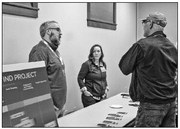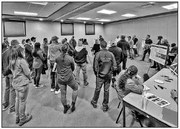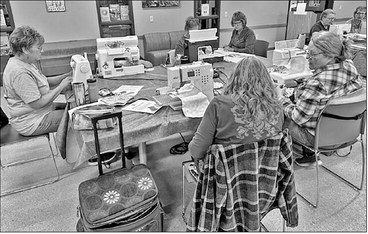Complaints aired about wind turbine companies


Farmland First, state reps encourage towns to pass ordinances
Two events transpired on Monday night that gave people clarity on what wind turbine companies are trying to accomplish in Clark and Marathon Counties. The two events, one hosted by RWE Renewables at the Abbotsford City Hall and the other hosted by Farmland First at the Curtiss Fire Hall, showed differing perspectives on the project.
RWE Renewables kicked off the night with their version of an open housestyle meeting. Residents could walk up to tables that had experts in the fields of engineering and turbine design, sound and frequency of the turbines, permitting, contract details and more. About 30 or so attendees cycled through for the first half hour of the town hall as they went from station to station.
About a half hour in, Martin Machtan, an organizing member of Farmland First, took charge of the event by grabbing attendees’ attention and asking RWE questions about the project.
He began his line of questioning by detailing the events that led up to the meeting. Machtan said he had emailed RWE on Feb. 22 to invite RWE to attend a March 13 meeting with representatives from both sides of the wind turbine debate in attendance. He said Julie Drennen from RWE was unable to pull a team together in that short of time.
Machtan said he emailed Drennen back four hours later and suggested March 27th as a date that was later and would give RWE enough time to get a team of representatives together. Machtan said he was notified shortly thereafter that the company had decided to plan their own event on that same day.
“Instead of having an open, public discussion, they chose to have a competing event,” Machtan said.
Machtan called for a vote on whether the crowd wanted a public discussion or whether people wanted to participate in RWE’s “marketing event.”
The crowd overwhelmingly voted for a public discussion and RWE officials allowed the event to turn into a questionand- answer session instead.
Machtan facilitated the discussion at the beginning, laying out some of the issues he had with RWE’s sales tactics and the way they were answering questions at the open house event. Alex Pinter, an attendee of the event, asked if anyone from RWE had a straightforward answer on what setbacks from tower to surrounding properties might look like. He said he had gone around and asked RWE representatives during the opening portion of the open house but was given non-specific answers which concerned him.
A representative responded with citing Wisconsin Public Service Commission Statute 128.
She said the chart inside PSC 128 would be very helpful to people who were concerned about setbacks. She said the setbacks would be 1,250 feet for nonparticipating residents homes, 1.1 times the height of the turbine (at maximum blade-tip height) for non-participating property owners’ property lines and 1.1 times the height of the maximum bladetip height for participating residents. For example, a 600-foot tall turbine would need to be placed at least 660 feet away from a participating land owner’s home.
Pinter said he specifically asked the employee the question and said she would not respond to him.
Another attendee brought up a scenario where would be unable to build a house on his own property if a tower was 660 feet away from his property line because the property would be within the required 1,250-foot setback to a nonparticipating residence.
“Because my neighbor wants to get greedy and make some money, I cannot do what I want to do with my land,” he said.
The complaints were publicly aired to RWE employees for about 40 minutes before the event went back to its original format.
Farmland First town hall
Around 300 people packed the Curtiss Fire Hall to gather information on the ongoing wind turbine discussion.
A panel of five members of Farmland First and local politicians spoke to the crowd. Panel members included: Machtan, Ryan LaSee, Jon Beran, Clark County Supervisor Fred Schindler and Clark County Supervisor Tom Wilcox.
The members each talked about ways the wind energy companies were not being honest in their eyes. Schindler kicked off the meeting by talking about the duties of local government to protect the citizens they serve.
“Who has the most power to do something about this in the next 30 to 60 days? The real power is in the township. Yes, an little-bitty six-by-six township with three supervisors. They can pass an ordinance that can protect your health, safety and wellbeing with two votes,” Schindler said.
He said the best thing townships can do is follow the lead of the Township of Lincoln in Eau Claire County.
He said they passed an ordinance that prevents wind energy companies from building turbines within a mile of a resident’s home and had a few other provisions in it that made it difficult for companies to build the turbines.
He said after the ordinance was made, the wind company that was exploring putting up turbines in that area, packed up and left.
He also talked about the contradiction from farmers accepting money for a wind farm when their farm is enrolled in a farmland preservation program.
“They are signing their farm up for an industrial wind complex,” Schindler said. “An industrial wind complex,” He reiterated. “And they’re in farmland preservation to preserve the farmland. It’s totally nuts.”
Wilcox told the crowd about the incidental take laws that apply to wind energy companies.
He said the wind energy companies have in their contract that they are allowed to incidentally take bald and golden eagles.
“Last time I checked, if a citizen possesses an eagle feather, the first offense fine is $100,000 or one year in prison, or both,” Wilcox said. “The federal government thinks enough of a bald eagle to fine you for possessing a feather. On the other hand, for green energy, you can get an incidental take permit.”
“Their take permit is more eagles per year than I see in a year. How can that be a green energy project?”
Beran spoke next as he laid out the issues with the sales tactics used by the companies after his parents who live in the Town of Johnson, had a first-hand experience with them.
He also dove into the financial impact the turbines could have on property value and tax revenue for governing bodies including the school districts. He said the financial gain from direct payments to landowners and tax payments to governmental entities would not be enough to offset the damage they would cause by decreasing resale value of homes and residents potentially moving away to get away from the turbines.
LaSee detailed the financing motivations for companies to target Marathon and Clark Counties for their project. He estimated that the companies would make $1.1 million per year off of a single turbine. He equated this number to close to a $1 billion in revenue for the wind company for all of its turbines in a wind project throughout the life of a 30-year project.
“We really aren’t a very windy area. Well, a penny saved, is a penny earned, right? In this case, an extra million is a million earned,” LaSee said.
Machtan finished by going through the injustices in the contracts and how the wind companies have put clauses in there that the common person might not question but could prove to be damaging down the road.
State senators Cory Tomczyk, Jesse James and Karen Hurd were in attendance along with a plethora of local and county officials.
Tomczyk encouraged local politicians to get this done from the ground, up. Hurd said she would work for the people to find answers from a state level.
About 15 peaceful protestors held signs reading “No Wind Turbines” at a ribbon-cutting event hosted by the Abby/Colby Crossings Chamber of Commerce and the Clark County Economic Development Corporation on Tuesday, March 28.
Both Colby-Abbotsford police chief Jason Bauer and Clark County Sheriff Scott Haines were in attendance to keep the peace.
A truck driven by LaSee, a founding member of the Farmland First organization, donned a large banner which displayed “No Wind Turbines” as well.

TOWN HALL TURNED Q&A -Left: Town of Colby Chairman Larry Oehmichen (right) spoke to Tyler Beemer of Burns & McDonnell (left) about the development timeline and permits at RWE’s open house on Monday. Right: The group then opened the discussion up for a public Q&A session.STAFF PHOTOS/NEAL HOGDEN

CAN YOU HEAR ME NOW? -Ryan LaSee drove a truck with a sizeable banner on it past the ribbon cutting of RWE’s office building on First Street in Abbotsford.STAFF PHOTO/NEAL HOGDEN





